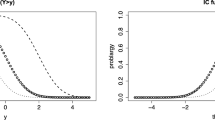Abstract
A model is presented for item responses when different subjects employ different strategies, but only responses, not choice of strategy, can be observed. Using substantive theory to differentiate the likelihoods of response vectors under a fixed set of strategies, we model response probabilities in terms of item parameters for each strategy, proportions of subjects employing each strategy, and distributions of subject proficiency within strategies. The probabilities that an individual subject employed the various strategies can then be obtained, along with a conditional estimate of proficiency under each. A conceptual example discusses response strategies for spatial rotation tasks, and a numerican example resolves a population of subjects into subpopulations of valid responders and random guessers.
Similar content being viewed by others
References
Birren, J. E., Cunningham, W. R., & Yamamoto, K. (1983). Psychology of adult development and aging.Annual Review of Psychology, 34, 543–575.
Carter, P., Pazak, B., & Kail, R. (1983). Algorithms for processing spatial information.Journal of Experimental Child Psychology, 36, 284–304.
Cooper, L. A., & Shepard, R. N. (1973). Chronometric studies of the rotation of mental images. In W. G. Chase (Ed.),Visual information processing (pp. 76–176). Orlando, FL: Academic Press.
de Leeuw, J., & Verhelst, N. (1986). Maximum likelihood estimation in generalized Rasch models.Journal of Educational Statistics, 11, 183–196.
Dempster, A. P., Laird, N. M., & Rubin, D. B. (1977). Maximum likelihood from incomplete data via the EM algorithm.Journal of the Royal Statistical Society, Series B,39, 1–38.
Embretson, S. E. (1985). Multicomponenet latent trait models for test design. In S. E. Embretson (Ed.),Testdesign: Developments in psychology and psychometrics (pp. 195–218). Orlando, EL: Academic Press.
Fischer, G. H. (1973). The linear logistic test model as instrument in educational research.Acta Psychologica, 36, 359–374.
French, J. W. (1965). The relationship of problem-solving styles to the factor composition of tests.Educational and Psychological Measurement, 25, 9–28.
Gagné, R. M. (1962). The acquisition of knowledge.Psychological Review, 69, 355–365.
Gentner, D., & Gentner, D. R. (1983). Flowing waters or teeming crowds: Mental models of electricity. In D. Gentner & A. L. Stevens (Eds.),Mental modelss (pp. 99–129). Hillsdale, NJ: Earlbaum.
Hulin, C. L., Drasgow, F., & Parsons, C. K. (1983).Item response theory: Application to psychological measurement. Homewood, IL: Dow Jones-Irwin.
Just, M. A., & Carpenter, P. A. (1985). Congnitive coordinate systems: Accounts of mental rotation and individual differences in spatial ability.Psychological Review, 92, 137–172.
Kyllonen, P. C., Lohman, D. F., & Snow, R. E. (1984). Effects of aptitudes, strategy training, and task facets on spatial task performance.Journal of Educational Psychology, 76, 130–145.
Lohman, D. F. (1979).Spatial ability: A review and reanalysis of the correlational literature (Technical Report No. 8). Stanford, CA: Stanford University, Department of Education, Aptitude Research Project.
Louis, T. A. (1982). Finding the observed information matrix when using the EM algorithm.Journal of the Royal Statistical Society, Series B,44, 226–233.
Macrae, K. S. (n.d.).Strategies underlying psychometric test responses in young and middle-aged adults of varying educational background. Unpublished manuscript, La Trobe University, Australia.
Messick, S. (1984). The psychology of educational measurement.Journal of Educational Measurement, 21, 215–237.
Mislevy, R. J. (1986). Bayes modal estimation in item response models.Psychometrika, 51, 177–195.
Mislevy, R. J., & Bock, R. D. (1983).BILOG: Item analysis and test scoring with binary logistic models. Mooresville, IN: Scientific Software.
Mislevy, R. J., & Verhelst, N. (1987).Modeling item responses when different subjects employ different solution strategies (Research Report RR-87-47-ONR). Princeton, NJ: Educational Testing Service.
Paulson, J. (1985).Latent class representation of systematic patterns in test responses (ONR Technical Report). Portland, OR: Protland State University.
Pellegrino, J. W., Mumaw, R. J., & Shute, V. J. (1985). Analysis of spatial aptitude and expertise. In S. E. Embretson (Ed.),Test design: Developments in psychology and psychometrics (pp. 45–76). Orlando, FL: Academic Press.
Piaget, J. (1960). The general problems of the psychological development of the child. In J. M. Tanner & B. Inhelder (Eds.),Discussions on child development: Vol. 4 (pp. 3–27). The fourth meeting of the World Health Organization Study Group on the Psychobiological Development of the Child, Geneva, 1956.
Ramsay, J. O. (1975). Soving implicit equations in psychometric data analysis.Psychometrika, 40, 361–372.
Samejima, F. (1983).A latent trait model for differential strategies in cognitive processes (Technical Reprot ONR/RR-83-1). Knoxville, TN: University of Tennessee.
Scheiblechner, H. (1972). Das lernen und lösen komplexer denkaufgaben [The studying and solving of complex conceptual problems].Zeitschrift für Experimentelle und Angewandte Psychologie, 19, 476–506.
Siegler, R. S. (1981). Developmental sequences within and between concepts.Monograph of the Society for Research in Child Development, 46 (2, Serial No. 189).
Tapley, S. M., & Bryden, M. P. (1977). An investigation of sex differences in spatial ability: Mental rotation of three-dimensional objects.Canadian Journal of Psychology, 31, 122–130.
Tatsuoka, K. K. (1983). Rule space: An approach for dealing with misconceptions based on item response theory.Journal of Educational Measurement, 20, 345–354.
Titterington, D. M., Smith, A. F. M., & Makov, U. E. (1985).Statistical analysis of finite mixture distributions. Chichester: Wiley & Sons.
Tsutakawa, R. K., & Soltys, M. J. (1988). Approximation for Bayesian ability estimation.Journla of Educational Statistics, 13, 117–130.
Wilson, M. R. (1984).A psychometric model of hierarchical development. Unpublished doctoral dissertation, University of Chicago.
Wison, M. R. (1989). Saltus: A psychometric model of discontinuity in cognitive development.Psychological Bullentin, 105, 276–289.
Yamamoto, K. (1987).A hybrid model for item responses. Unpublished dissertation, University of Illinois.
Author information
Authors and Affiliations
Additional information
The first author's work was supported by Contract No. N00014-85-K-0683, project designation NR 150-539, from the Cognitive Science Program, Cognitive and Neural Sciences Division, Office of Naval Research. We are grateful to Murray Aitkin, Isaac Bejar, Neil Dorans, Frederiksen, and Marklyn Wingersky for their comments and suggestions, and to Alison Gooding, Maxine Kingston, Donna Lembeck, Joling Liang, and Kentaro Yamamoto for their assistance with Example 2.
Rights and permissions
About this article
Cite this article
Mislevy, R.J., Verhelst, N. Modeling item responses when different subjects employ different solution strategies. Psychometrika 55, 195–215 (1990). https://doi.org/10.1007/BF02295283
Received:
Revised:
Issue Date:
DOI: https://doi.org/10.1007/BF02295283




